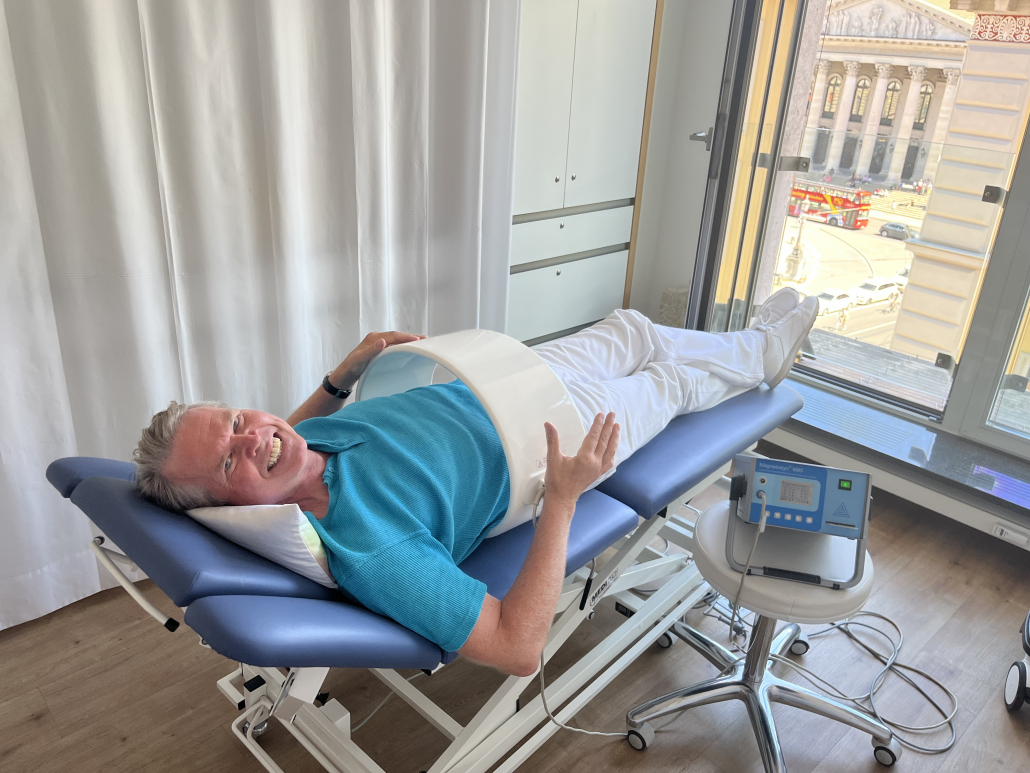Magnetodyn® magnetic field therapy
Proven integrative therapy method
Sinusoidal, low frequency electromagnetic fields can be used preventively and therapeutically – for example for connective tissue, vascular, bone regeneration, etc., but also to improve the immune system and defense against inflammations. The procedure has proven itself in our practice for decades.
Magnetodyn® magnetic field therapy in our gynecological practice in Munich
Magnetodyn® magnetic field therapy is an integrative therapy method in which sinusoidal, low frequency electromagnetic fields are used preventively and therapeutically. They can contribute to the regeneration of connective tissue, blood vessels, bones, etc. They have a beneficial effect on the autonomic nervous system, they improve the general immune system and defense against infections, they relieve pain and harmonize cell functions. The magnetic fields can stimulate injured tissue in such a way that it heals faster and – whenever possible – without complications. Acute and chronic pain can be alleviated, the metabolism can be supported and healing processes can be accelerated, etc.
Proven procedure in outpatient treatment – painless and free of side effects
Magnetodyn® magnetic field therapy has proven itself in our gynecology practice in Munich for many years. The technology was developed by Dipl. Physicist Werner Kraus and Prof. Dr. med. Fritz Lechner. The therapy unit consists of a control unit, a generator and acoil.
The treatment is on an outpatient basis. The affected part of the body is treated in the coil for a certain period of time, depending on the respective indication. Pain free and side effect free. The therapy takes place two to three times a week over a period of three to six weeks.
Magnetodyn® magnetic field therapy – recommended for a wide variety of indications
In our gynecological practice located in the heart of Munich, we carry out Magnetodyn® magnetic field therapy for the following indications (selection):
Magnetodyn® pain therapy: headache, migraine, period pain, lumbago, sciatica, osteoporosis, arthrosis, rheumatism, shoulder arm syndrome, cervical spine, lumbar spine, thoracic spine syndrome, pain in the stitches, knees, elbows, adhesion pain, e.g. after operations and inflammation, scar pain, etc.
Magnetodyn® for the metabolism: stress, burnout syndrome, exhaustion, cancer (integratively), immune deficiency, frequent infections, as an anti aging measure, to harmonize the hormone system, for psychological balance, depression, anxiety, for bone and connective tissue metabolism, etc.
Magnetodyn® in gynaecology: menstrual disorders, hormonal disorders, menopause symptoms, bone and joint pain, fibroids, endometriosis, PCOS, hormone dependent migraine, infertility, period pain, weak connective tissue, cellulite, venous weakness, adhesion pain, scars, etc.
Other indications for Magnetodyn®: metabolic disorders, hormone disorders, digestive disorders, obesity, cholesterol disease, high blood pressure, cardiac arrhythmia, tinnitus, electrical sensitivity, alcohol and nicotine addiction, food intolerance, allergies, hay fever, weather sensitivity, depression, fears, restlessness, etc.
Background-Info
Magnetodyn® magnetic field therapy is an integrative therapy method that has proven itself in our practice for decades e.g. to harmonize cell functions, to relieve acute and chronic pain, to strengthen connective tissue and muscles, for joints and fascia, for vessels and bones, to improve immune defense, against inflammations, etc.
Literature (selection)
Literature (selection)
SCHULTE-UEBBING, C.: Belastungsinkontinenz (Stress-Inkontinenz) – Extrakorporale Magnetfeldtherapie als unterstützende Behandlungsoption kann zusammen mit hormoneller Behandlung und gezieltemBeckenbodentraining helfen, CO’MED, 2 / 2011, S. 1-4
QUEK, P.: A critical review on magnetic stimulation: what is its role in the management of pelvic floor disorders?, Curr Opin Urol 7 / 2005; 15 (4), pp. 231- 5
SCHULTE-UEBBING, C.: High dose vaginal vitamin D treatment against dysplasia (CIN I, II), chronical recurrant cervicitis and stress incontinance. Menopause Kongress, University of Vienna, Austria, 12 / 2010
SCHULTE-UEBBING, C., SCHLETT, S.: Kolpitis und Co – vaginale Vitamin- D- Applikation hilft, gynäkologie und geburtshilfe 3 / 2010, S. 2 ff.
SCHULTE-UEBBING, C., SCHLETT, S.: Vitamin D in der gynäkologischen Praxis, Ergebnisse einer Anwendungsbeobachtung, CO’MED, 3 / 2010, S. 1 ff.
KNOLL, B., SCHULTE-UEBBING, C.: Frauenkrankheiten mit Meso- Therapie natürlich behandeln, München, 7 / 2006
SCHULTE-UEBBING, I.D. CRAIUT: Beckenboden-Schwäche der Frau, Ganzheitliche Therapeutische Ansätze, Z. Ärzte f. Naturheilverfahren, 9 / 2014
SCHULTE-UEBBING, C.: Beckenbodenschwäche – Das heimliche Tabuthema vieler Frauen, Ihre Gesundheit, 5 / 2013
SCHULTE-UEBBING, C., SCHLETT, S., CRAIUT, I.D., BUMBU, G., HOFSTETTER, A., CRAIUT, L.: Vitamin D gegen Belastungs- Inkontinenz (BIK)? Hochdosiertes Cholecalciferol kann die Effekte von lokalem Östriol bei der Behandlung der Stress-Inkontinenz (Grad I und II) verbessern, Internationaler Vitamin D- Kongress, Virchow Klinikum, Universität Charité, Berlin, 4 / 2013
SCHULTE-UEBBING, C., SCHLETT, S.: Beckenboden- Schwäche, In: Frauenheilkunde, Benno Verlag, Leipzig, 334 Seiten, 12 / 2011
SCHULTE-UEBBING, C., SCHLETT, S., KLEINE-GUNK, B., CRAIUT, I. D., BUMBU, G., ROTHENBERGER, K.H., OLAH, H.: Stage I and II Stress Incontinence. High dosed Vitamin D may improve effects of local estriol, 6. congress of the Romanian society of gynecology and endocrinology, Jurnal de Ginecologie Endocrinologica, Vol. 1, nr 2 – 3, aprilie- septembrie, Bucarest, 2011, pp. 34–39
BUMBU, G., BERECHET, M.C., BUMBU, A., SCHULTE-UEBBING, C.: Cervicocolpopexia transobturatorie în managementul chirurgical al prolapsului urogenital avansat, Gineco-ro, Nr. 23, 1 / 2011
SCHULTE-UEBBING, C.: Vitamin D in der Gynäkologie, Kongress, German Society Anti Aging Medicine GSAAM, München, 5 / 2011
SCHULTE-UEBBING, C., GERHARD, I.: Hochdosiertes vaginales Vitamin D gegen Cervizitis und Dysplasien, Netzwerk Frauengesundheit, 3 / 2011
SCHULTE-UEBBING, C.: Östriol und Vitamin D intravaginal bessern Stressinkontinenz, Studie mit 60 Patient*innen, Privatarzt, 2 / 2011, S. 32 ff.
SCHULTE-UEBBING, C., SCHLETT, S.: Vitamin D Therapie bei Belastungsinkontinenz, gynäkologie + geburtshilfe, 11 / 2010
SCHULTE-UEBBING, C., SCHLETT, S.: Vaginale Vitamin D Anwendung, Workshop Beckengesundheit, Kongress für Gynäkolog*innen, Ostseebad Damp, 9 / 2010
SCHULTE-UEBBING, C.: Beckenboden- Schwäche, In: Lehrbuch Angewandte Umweltmedizin, Sonntag (Thieme), Stuttgart, 1995 (440 Seiten)
SCHULTE-UEBBING, C.: Beckenboden- Schwäche der Frau, Therapie- Konzepte, In: Frauenheilkunde, Pattloch Verlag, Augsburg, 1995
SCHULTE-UEBBING, C.: Umweltmedizinische Aspekte von Bindegewebs- und Beckenboden- Schwäche, In: Umweltkrankheiten natürlich behandeln, Pattloch, Augsburg, 1995, 212 Seiten
SCHULTE-UEBBING, C.: Beckenboden- Schwäche, Diagnostik, Therapie und Prävention, In: Lehrbuch Umweltbedingte Frauenkrankheiten, Sonntag (Thieme), Stuttgart, 1994 (405 Seiten)
ZAHN, V., SCHULTE-UEBBING, C.: Beckenboden- Schwäche, In: Lehrbuch der Umweltmedizin, UMGEWE, Straubing, 1991 (560 Seiten)
Our services
How can we help you?
We are happy to be here for you.
Do you have unclear symptoms and need professional advice or come to us with an existing diagnosis? We warmly welcome you to our practice for gynecology in the center of Munich.


